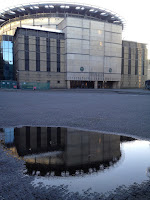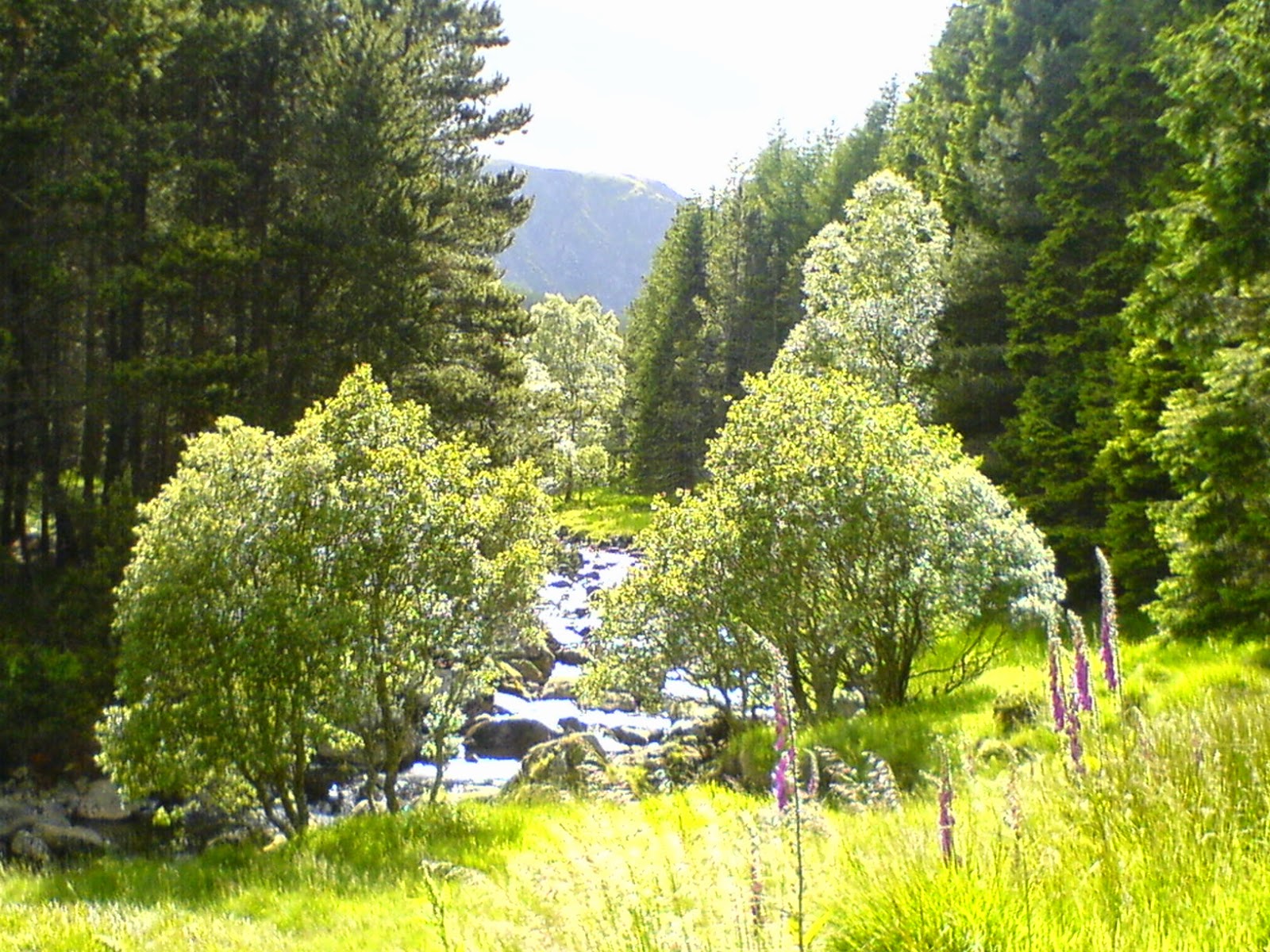Plant More Trees
The conference was opened with what Muriel Gray described as a hand-grenade from Raymond Henderson of agribusiness consultant Bidwells, who pointed out that in 2013-15, only 3000ha of productive forestry was planted in Scotland. Scotland is 8 million ha, so to increase forest cover from 18% to 19% requires three areas the size of Edinburgh. The target for new forest by 2022 is 100,000ha, or four Edinburghs. Stuart Goodall, head of Confor, pointed out that there is no point planting new land unless you are also re-stocking felled areas (if you have travelled through the Scottish countryside recently you will know a huge amount of felling is going on), and statistics on this are sketchy. Keep an eye on this: it is important. |
| The City of Edinburgh area (marked here) is 26,000ha. |
 |
| Jo O'Hara's slide showing forestry planting (conifer in blue, broadleaved in red) by decade since the 1970s. The line at the top is 16,000ha. |
There was good news too: Andrew Vaughan, a regional manager with Tillhill forestry company, provided an inspiring case-study of their new planting scheme at Jerrah above Menstrie in the Ochils. Jerrah resulted in 1.3 million trees of 16 species over 583 hectares, and two PhDs.
Regulation
Raymond Henderson identified a major problem with the grant and regulatory system as the reason so little forest had been planted. Andrew Vaughan pointed out that to deliver planting targets will require many Jerrahs, and under current regulation this would require Environmental Impact Assessment documentation amounting to three Bibles. Tillhill is working on another scheme, Hawkhill: the new Forth Bridge will be built within the time it takes Hawkhill to go through the regulatory process.Green Gold
This phrase was coined by Professor Sean Smith, Director of the Institute for Sustainable Construction at Napier. The representatives of the forestry industry in the room were delighted with it, so prepare to hear it more often. Andrew Heald, Technical Director of Confor, pointed out that Between 2008 (the start of the recession) and 2015, there was a 50% growth in Scottish forestry jobs.Sean pointed out that a modern timber-frame house has energy bills one seventh of the Scottish average. Faced with the need to design for climate change, wood is capable of far more resilient constructions in the face of high winds than other materials. The fact that the new Edinburgh school wall which fell down in Storm Gertrude was brick was no coincidence.
Andrew Heald wanted to challenge the perception that Scottish timber is used to make toilet roll when it is mainly used in construction. Imagine growing a crop, he said, which needs no fertilizer or maintenance, grows on poor soil, for which demand's set to double, which produces a construction material in a landscape which people want to go mountainbiking in - and does carbon capture and storage in the process. You wouldn't go mountainbiking in a brickworks.
Public engagement
The panelists were in agreement that the forestry industry has learned from the regulatory mistakes of the past, and now must learn from the PR mistakes of the past. Jo O'Hara said that there are over 90 million visits a year to Scottish woodlands. Yet Andrew Heald pointed out that few of those 90 million come away with any idea that they have been in the midst of a £1bn industry, of green gold: many do not realise forests such as Glen Tress are productive at all.Andrew Vaughan said that, according to the authorities, 100,000 people a year look over the Jerrah site from the top of Dumayat, but very few turn to look that way because they are all looking at the spectacular view of the Forth Valley. Yet the Jerrah scheme had to be redesigned so as not to be visible from Dumayat, or indeed to anyone looking at the Ochils by telescope from Edinburgh. He was making a point about the amount of design work required to satisfy regulations, but some of us environmentalists at the back muttered to each other that it was a shame the opportunity was not taken to re-educate people's perceptions of the Scottish landscape, by allowing them a glimpse of a well-designed productive forest.
 |
| City trees: Princes Street Gardens on the way to the conference |
83% of Scots agree with the statement that a lot more trees should be planted. I was pleased Andrew Heald mentioned my project Wild Reekie, aimed at ordinary city types -- those 83%, in fact -- as an example of the kind of public engagement the forestry sector ought to be doing. It's the kind of engagement I, as an environmentalist, also think we ought to be doing so I'm delighted to see a £1bn Scottish industry getting behind it.
Elizabeth Barron-Majerik, head of the Scottish School of Forestry, gave an important presentation on protecting the industry's skills base, and reversing the declining knowledge of the sector amongst young people. She did exactly what I did when writing my Gender and Diversity report: google for 'diversity in forestry':
 |
| Google search for 'diversity in Scottish forestry' |
This need for education was the theme of my Diversity and Gender report which people picked up in coffee-break conversations. One suggestion I liked was to revive the Guides forestry badges.
Sheep and Water
The conference gained a buzz from the fact that the importance of forestry in Scottish upland land-use has been high on the public agenda recently, both in terms of natural flood prevention, and of diversification for sheep farmers.Jo O'Hara mentioned the support given a few weeks ago by the National Sheep Association to productive forestry in the Scottish uplands, which she sees as a huge breakthrough and accompanied by a significant change of mood.
Andrew Vaughan talked about the potential of Jerrah for reducing flooding in Menstrie. Historic farming practices had created 96km of drainage ditches linking into the Menstrie Burn: no wonder it floods. It is obvious to anyone who has walked through a wood after rain and seen a raindrop hanging on every needle, that once a forest grows up to 'canopy closure', runoff from a heavy rainstorm will be enormously slowed. But long before that, the modern skills in designing drainage ditches to drain 'uphill', and into wetland areas rather straight into the river, should be a huge improvement on the previous improved grassland.
 |
| A larch forest preventing rain reaching the ground. |
Who is my community?
There were presentations on community engagement from Rural Development Consultant Amanda Bryan and Fergus Tickell, chair of the Argyll Timber Transport Group which focused on the rural community. Yet to me, this is not addressing the 70% of us who live in the Central Belt -- those of us who 'want more forests', 'think Scottish timber is made into toilet paper', and have a vague dislike of conifers. The divide between the populated, urban central belt and the rural north, west coast and south is so great in Scotland, and so important to forestry, that it needs to be identified and discussed.With my 'diversity' hat on, I thought the rural-urban divide was particularly evident on the political panel. Andy Wightman (Green) is a candidate for the Lothians, but Claudia Beamish (Labour), Alex Fergusson (Conservative) and Jim Hume (Liberal Democrat) are all MSPs in the South Scotland region while Michael Russell (SNP) is MSP for nearby Argyll and Bute. They were also mostly members of the Rural Affairs, Climate Change and Environment Committee.
It was striking, and cheering for those of us who like consensus, how far the political panel were in agreement with each other and with the foresters. Michael Russell said the two top priorities for the next parliament should be reducing the bureaucracy involved in new planting schemes, and improving deer control. The other parties were generally in agreement. I was surprised that the only spontaneous applause from this rural industry was for the Green, Andy Wightman, who said that instead of having a Cabinet Secretary for Rural Affairs, Food and Environment, who claims to 'represent farmers', with an Environment Minister underneath, there should be a Cabinet Secretary for the Environment, with Agriculture and Forestry Ministers underneath.
But I did wonder, how many of the urban colleagues of that well-informed and consensual cross-party panel would understand or care about the timber industry, natural flood management, or ensuring planting or re-stocking targets are met? Was this a 'forestry interest' just talking to itself? It's the politicians who have the strong links into the rest of society, and so this is my challenge to them: over the election period and in the next parliament, to get their central belt colleagues out into the woods with some of those forward-thinking foresters -- or their party risks getting left behind at the place where £1bn industry meets environmental crisis.
Before you go, spend two minutes watching the new Confor video -- and make sure you go into a wood next weekend...
Eleanor Harris is a historian and environmentalist. She can be found @eleanormharris or on her rather out-of-date website at eleanormharris.co.uk.






















































